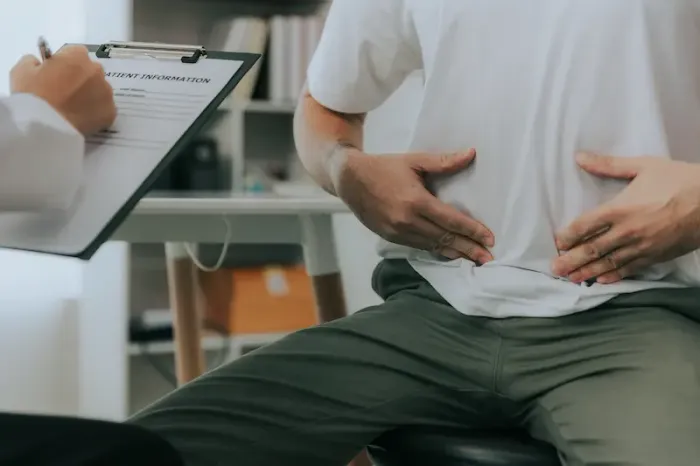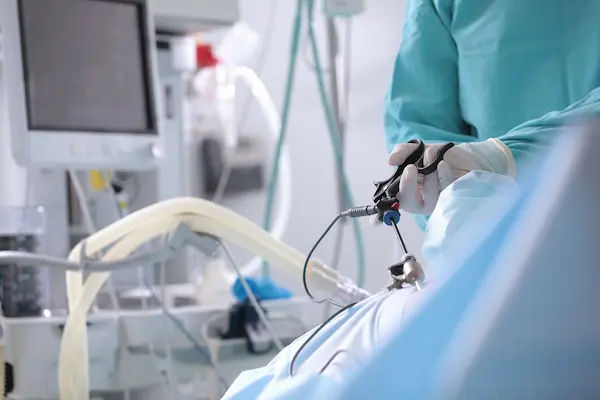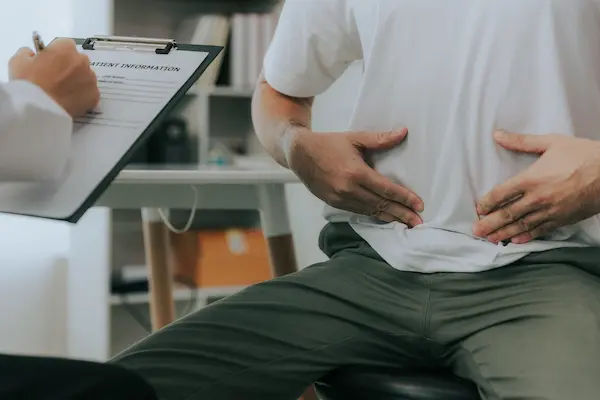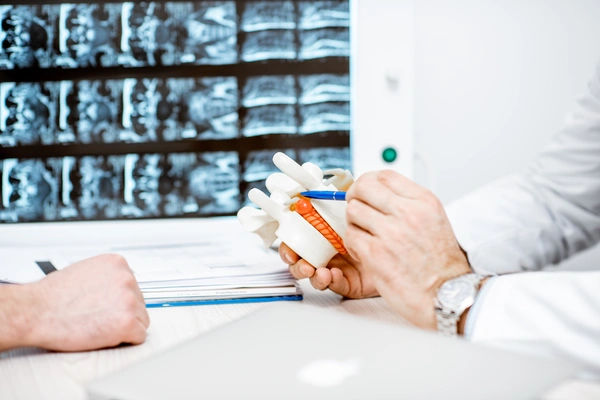What Leads to Signs of Hernia Definition, Symptoms, and Treatment
A hernia occurs when internal tissue pushes through a weak spot in muscle, causing a bulge or discomfort. This comprehensive guide explains what leads to signs of hernia, the different types, early symptoms, diagnosis, and the latest non-surgical and surgical treatment options. Learn when to seek help and how Apollo 24|7 can support your care journey.

Written by Dr. Md Yusuf Shareef
Reviewed by Dr. D Bhanu Prakash MBBS, AFIH, Advanced certificate in critical care medicine, Fellowship in critical care medicine
Last updated on 29th Oct, 2025

Introduction
If you have recently noticed a new lump near your groin or belly button—or found yourself struggling with persistent heartburn—you may be worried about a possible hernia. A hernia develops when an organ or tissue pushes through a weak area in the muscle or connective tissue that usually keeps everything in place. Depending on the type and location, this may appear as a visible bulge or remain hidden internally, causing symptoms such as pressure, discomfort or digestive issues.
Not all hernias are dangerous, but some can trap tissue and block blood supply, making timely recognition essential. Understanding why hernias occur helps you take practical steps to reduce pressure on your abdomen and avoid complications. In this article, we explore what leads to signs of hernia, key causes, common symptoms, who is at risk, how diagnosis is made, and modern treatment approaches—including minimally invasive repairs. You will also find guidance on when to consult a doctor and lifestyle measures that support recovery and prevention.
Consult a Top Surgeon for Personalised Advice
What is a hernia? Clear definition and how it develops
A hernia forms when internal tissue pushes through a weak spot in the surrounding muscle or fascia.
The basic definition
A hernia is a protrusion of abdominal contents—usually intestine or fat—through a weakened section of the abdominal wall. This gap allows tissue to bulge outward, forming a noticeable lump in certain positions such as standing, lifting or coughing. In some cases, the bulge may disappear when lying down.
The pressure–weakness equation
Two main factors create hernias:
• Weak tissue — due to ageing, genetics, pregnancy, previous surgery, or natural structural openings such as the groin canal.
• Increased internal pressure — from sudden lifting, repeated coughing, constipation or weight gain.
When pressure exceeds tissue strength, the wall stretches and a hernia emerges.
Why this definition matters
Fixing symptoms often requires reducing strain and strengthening tissue—but long-term repair usually involves closing the gap surgically, especially if symptoms persist or the hernia grows.
How common are hernias, and who is at risk?
Hernias are extremely common worldwide, especially in adults and those with lifestyle or medical risk factors.
How often do they occur
• Inguinal (groin) hernias are the most widespread and occur far more often in men.
• Umbilical hernias appear frequently in newborns and in adults with raised abdominal pressure.
• Hiatal hernias increase with age and obesity.
Millions of repairs are performed every year, making hernia surgery one of the most common operations globally.
Key risk factors
• Heavy lifting and physically demanding jobs
• Chronic cough from smoking or lung conditions
• Constipation or straining with bowel or urinary issues
• Pregnancy and rapid or major weight changes
• Previous abdominal surgery (incisional hernia risk)
• Smoking, which weakens connective tissue
• Family history or connective tissue disorders
A practical perspective
Having risk factors does not guarantee a hernia—but addressing what you can control may slow progression and reduce pain.
Types of hernias (and how they behave differently)
Hernia symptoms vary widely depending on the type and anatomical location.
Inguinal hernia (groin)
This type occurs in the groin region and may extend into the scrotum. Many are reducible—meaning the bulge can be pushed back in.
Femoral hernia
More common in women, found just below the groin crease. Although often small, these carry a greater risk of complications and usually require earlier surgery.
Umbilical hernia
Appears around the belly button. In young children, many close naturally by age 3–5. In adults, obesity and pregnancy are major contributors.
Incisional hernia
Occurs at a previous surgical scar where healing was incomplete or strain occurred. These can grow larger over time.
Hiatal hernia
Happens when part of the stomach slides up into the chest through the diaphragm. Symptoms include heartburn and regurgitation rather than a visible bulge.
Less common types
Epigastric, Spigelian and complex abdominal wall hernias require specialist evaluation to determine the best repair.
Signs and symptoms you should not ignore
Symptoms depend on the hernia’s type, size and whether tissue is trapped.
Classic signs
• A bulge that becomes more noticeable when standing or straining
• Discomfort, pressure or sharp pain at the site
• Groin heaviness after lifting
• For hiatal hernia: heartburn, regurgitation or swallowing difficulty
Red flags requiring urgent care
Seek immediate help if you experience:
• Severe pain and tenderness over a firm lump
• Nausea, vomiting or inability to pass stool or gas
• Skin discolouration over the bulge
These may indicate incarceration (tissue stuck) or strangulation (blood supply cut off).
H3: Women, children and subtle signs
• Women may have pain without an obvious lump—ultrasound is often useful.
• Children with an inguinal hernia generally require prompt repair to prevent complications.
If symptoms persist beyond two weeks, consult a doctor online with Apollo 24|7 for assessment.
What leads to signs of a hernia? Causes and mechanisms
Symptoms appear when internal pressure repeatedly pushes tissue into the hernia opening.
The “load vs wall” concept
Abdominal pressure rises during lifting, coughing or straining, forcing tissue outward. Over time, this increases bulge size and discomfort.
Why certain movements trigger pain
Coughing produces sharp spikes in pressure, while lifting creates longer strain—both stretch the hernia sac and surrounding nerves.
Tissue biology and healing ability
Ageing, diabetes and smoking weaken collagen, slowing tissue repair and increasing the likelihood of a hernia forming or recurring.
How hernias are diagnosed
Diagnosis usually begins with a physical examination and may involve imaging if unclear.
Clinical evaluation
Doctors examine the area while you stand or cough to see if the hernia protrudes. They check its size, tenderness and whether it can be gently reduced.
Imaging tests when needed
• Ultrasound for groin and abdominal wall hernias
• CT scan to assess incisional or unclear anatomy
• MRI for specific athletic groin injuries
• Endoscopy or barium swallow for hiatal hernia and reflux symptoms
Pre-operative checks
If surgery is planned, routine blood tests and imaging may be needed. Apollo 24|7 enables convenient home sample collection where suitable.
Non-surgical management and self-care
Conservative care can control symptoms temporarily for selected patients.
Watchful waiting
Appropriate for certain minimally symptomatic inguinal hernias in men. Symptoms should be monitored regularly to detect worsening. Femoral hernias typically should not wait.
Lifestyle measures to reduce strain
• High-fibre diet and hydration to prevent constipation
• Stop smoking and treat chronic cough
• Maintain healthy body weight
• Learn safe lifting techniques
• Strengthen core muscles with physiotherapy guidance
Hernia belts and binders
Support garments may temporarily improve comfort for those awaiting surgery or unsuitable for an operation. They do not repair the weakness and require regular reassessment.
Surgical treatments and mesh options
Surgery is the only definitive treatment and prevents complications.
When surgery is recommended
• Pain or activity limitation
• Non-reducible hernia
• Femoral hernia (higher risk of strangulation)
• Incisional hernias that enlarge
• Hiatal hernias with ongoing severe reflux or breathing difficulty
Different surgical approaches
• Open repair: Single incision near the hernia
• Laparoscopic or robotic repair: Small keyhole incisions offering quicker recovery
Mesh vs no mesh
Mesh strengthens weakened tissue and reduces recurrence in many cases. Some small hernias can be repaired without mesh, depending on patient factors.
Mesh safety considerations
Complications are uncommon when procedures are performed by experienced surgeons. Discuss any concerns with the surgical team.
Recovery, risks and prevention
Good aftercare and risk management improve recovery and long-term outcomes.
What to expect after surgery
• Pain is usually manageable with oral medication
• Walking is encouraged within hours of surgery
• Return to desk work within 1–2 weeks; manual jobs may take longer
Potential complications
Seroma, wound infection or recurrence can occur in a minority of cases. Nerve-related chronic pain is possible after open groin repair.
Preventing future hernias
• Maintain a healthy weight
• Avoid sudden heavy lifting
• Treat constipation early
• Support incisions properly during recovery
Special situations: women, athletes, pregnancy and children
Different groups may have unique risks and presentation patterns.
Women and femoral hernias
These can be small yet dangerous. Persistent groin discomfort deserves careful evaluation.
Athletes and “sports hernia”
Often involves core muscle injury rather than a true hernia; specialist input ensures proper diagnosis.
Pregnancy and postpartum
Hernias may appear temporarily due to increased pressure. Repairs are usually delayed until after childbirth unless complications occur.
Children
Paediatric inguinal hernias require timely repair, whereas many umbilical hernias resolve naturally.
When to see a doctor (and how Apollo 24|7 can help)
Timely medical evaluation reduces the risk of complications.
Do not delay if you notice:
• Bulge that is painful, persistent or enlarging
• Severe heartburn not relieved with simple treatment
• Vomiting, fever or a stuck hernia lump
Fast access to care
If symptoms persist beyond two weeks, consult a doctor online with Apollo 24|7 for initial review and advice. If conservative steps do not improve your condition, schedule an in-person examination for hands-on assessment.
Support through the surgical journey
Apollo 24|7 can coordinate pre-operative tests and postoperative care to ensure safe recovery.
Conclusion
Hernias are very common and usually treatable conditions caused by tissue pushing through a weakened area of support. Recognising the early signs—whether a groin bulge or ongoing acid reflux—is key to preventing serious complications like strangulation. Many people can manage mild symptoms for a while with lifestyle modifications, but surgery remains the definitive treatment for most hernias, and outcomes are excellent when performed by experienced surgeons.
Understanding what leads to signs of hernia empowers you to protect your health: maintain a healthy weight, treat chronic cough or constipation promptly, and seek timely medical evaluation. If you are concerned about a possible hernia, Apollo 24|7 can connect you with qualified specialists who can guide diagnosis, treatment and recovery, ensuring the safest and most effective care.
Consult a Top Surgeon for Personalised Advice
Consult a Top Surgeon for Personalised Advice

Dr Karthik Maripeddi
Urologist
13 Years • MBBS MS FMAS MCh URO(OSM)
Hyderguda
Apollo Hospitals Hyderguda, Hyderguda

Dr. Sunil Kaul
General Surgeon
30 Years • MBBS, MS, FICS, FIMSA, FMAS
Delhi
Apollo Hospitals Indraprastha, Delhi
(25+ Patients)

Dr. Premkumar Balachandran
General and Laparoscopic Surgeon
22 Years • MBBS, MS, FICS, DMAS, FMAS, FRS, FIAGES, Dip. ALS, FCP
Chennai
Apollo Hospitals Greams Road, Chennai
(175+ Patients)
Dr. Naziya Rahim Bhatia
General Surgeon
7 Years • MBBS ,MS
Bengaluru
Apollo Clinic, Sarjapur Road, Bengaluru

Dr. Hozefa Lokhandwala
Surgical Oncologist
10 Years • MBBS, MS (General Surgery), DrNB (Surgical Oncology). Consultant - Surgical Oncologist & HIPEC Specialist Special Interest in Gl & Gynaec Cancer Surgeries.
Indore
Apollo Hospitals Vijay Nagar, Indore
Consult a Top Surgeon for Personalised Advice

Dr Karthik Maripeddi
Urologist
13 Years • MBBS MS FMAS MCh URO(OSM)
Hyderguda
Apollo Hospitals Hyderguda, Hyderguda

Dr. Sunil Kaul
General Surgeon
30 Years • MBBS, MS, FICS, FIMSA, FMAS
Delhi
Apollo Hospitals Indraprastha, Delhi
(25+ Patients)

Dr. Premkumar Balachandran
General and Laparoscopic Surgeon
22 Years • MBBS, MS, FICS, DMAS, FMAS, FRS, FIAGES, Dip. ALS, FCP
Chennai
Apollo Hospitals Greams Road, Chennai
(175+ Patients)
Dr. Naziya Rahim Bhatia
General Surgeon
7 Years • MBBS ,MS
Bengaluru
Apollo Clinic, Sarjapur Road, Bengaluru

Dr. Hozefa Lokhandwala
Surgical Oncologist
10 Years • MBBS, MS (General Surgery), DrNB (Surgical Oncology). Consultant - Surgical Oncologist & HIPEC Specialist Special Interest in Gl & Gynaec Cancer Surgeries.
Indore
Apollo Hospitals Vijay Nagar, Indore
More articles from Hernia
Frequently Asked Questions
1) What are the first signs of a hernia in men?
Common early signs include a groin bulge that appears with standing or coughing and a dull ache or heaviness in the area. It may reduce when lying down. If pain is severe or the bulge is stuck, seek urgent care.
2) How do hernia symptoms differ in women?
Women may have subtler groin symptoms and are more likely to have a femoral hernia, which can be small but higher risk for strangulation. Ultrasound helps when the exam is uncertain.
3) Can a hernia be treated without surgery?
Lifestyle steps—managing constipation, cough, weight, and lifting technique—can reduce symptoms. Watchful waiting is reasonable for some minimally symptomatic inguinal hernias in men, but many hernias ultimately need repair, and femoral hernias should not be delayed.
4) How do I know if my heartburn is a hiatal hernia?
Hiatal hernia can mimic GERD with heartburn and regurgitation. Persistent symptoms despite OTC therapy, difficulty swallowing, or anaemia warrant evaluation. Tests like endoscopy or barium swallow can confirm.
5) How long is the hernia recovery time after surgery?
Most people walk the same day. Many return to light activity within 1–2 weeks and avoid heavy lifting for several weeks, depending on the repair and job demands. Your surgeon will personalised guidance.




